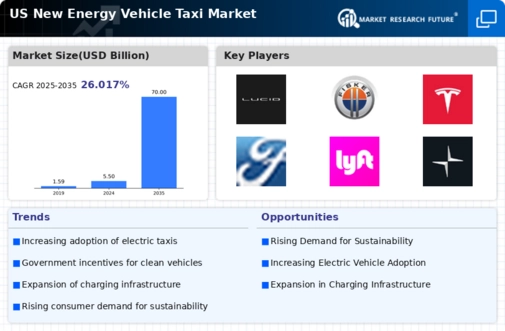Rising Fuel Costs
The increasing costs of traditional fuels have a profound impact on the new energy-vehicle-taxi market. As gasoline prices fluctuate, consumers and taxi operators are increasingly seeking alternatives that offer cost savings. The shift towards electric vehicles (EVs) is particularly notable, as they can significantly reduce operational expenses. For instance, the average cost of electricity for EVs is approximately $0.13 per kWh, compared to gasoline prices that can exceed $3.00 per gallon. This economic incentive is driving the adoption of new energy vehicles in the taxi sector, as operators aim to enhance profitability while meeting consumer demand for more sustainable transportation options. Consequently, the rising fuel costs are likely to propel the growth of the new energy-vehicle-taxi market, as more stakeholders recognize the financial benefits of transitioning to electric fleets.
Urbanization and Population Growth
The ongoing trend of urbanization in the United States is a significant driver for the new energy-vehicle-taxi market. As cities expand and populations increase, the demand for efficient and environmentally friendly transportation solutions intensifies. Urban areas are often characterized by high traffic congestion and pollution levels, prompting local governments to encourage the adoption of electric taxis. For example, cities like Los Angeles and New York have implemented initiatives to promote electric vehicle usage, including dedicated charging infrastructure and incentives for taxi operators. This urban shift not only supports the growth of the new energy-vehicle-taxi market but also aligns with broader sustainability goals aimed at reducing carbon emissions in densely populated regions.
Environmental Regulations and Standards
Stringent environmental regulations are increasingly shaping the landscape of the new energy-vehicle-taxi market. Federal and state governments are implementing policies aimed at reducing greenhouse gas emissions and promoting cleaner transportation options. For instance, California has set ambitious targets for reducing emissions from transportation, which directly impacts taxi operators. Compliance with these regulations often necessitates a shift towards electric vehicles, as they produce zero tailpipe emissions. This regulatory environment not only encourages the adoption of new energy vehicles but also fosters innovation within the industry. As taxi companies strive to meet these standards, the new energy-vehicle-taxi market is likely to experience accelerated growth, driven by the need for compliance and the desire to contribute to environmental sustainability.
Consumer Awareness and Demand for Green Solutions
There is a growing consumer awareness regarding environmental issues, which is significantly influencing the new energy-vehicle-taxi market. As individuals become more conscious of their carbon footprints, there is an increasing demand for green transportation options. Surveys indicate that a substantial % of consumers prefer using electric taxis over traditional gasoline-powered vehicles, reflecting a shift in consumer preferences. This trend is further supported by the rise of ride-sharing platforms that prioritize sustainability, offering electric vehicle options to their users. As consumer demand for eco-friendly solutions continues to rise, taxi operators are likely to adapt their fleets accordingly, leading to a more robust new energy-vehicle-taxi market. This shift not only meets consumer expectations but also aligns with broader societal goals of reducing environmental impact.
Technological Innovations in Charging Infrastructure
Advancements in charging infrastructure are crucial for the expansion of the new energy-vehicle-taxi market. The development of fast-charging stations and widespread availability of charging points enhances the feasibility of operating electric taxis. As of November 2025, there are over 100,000 public charging stations across the United States, a figure that continues to grow. This proliferation of charging options alleviates range anxiety among taxi operators and drivers, making electric vehicles a more attractive choice. Furthermore, innovations such as wireless charging and ultra-fast charging technologies are expected to further enhance the convenience and efficiency of electric taxis. As the charging infrastructure evolves, it is likely to bolster the adoption of new energy vehicles in the taxi industry, facilitating a smoother transition to sustainable transportation.

















Leave a Comment